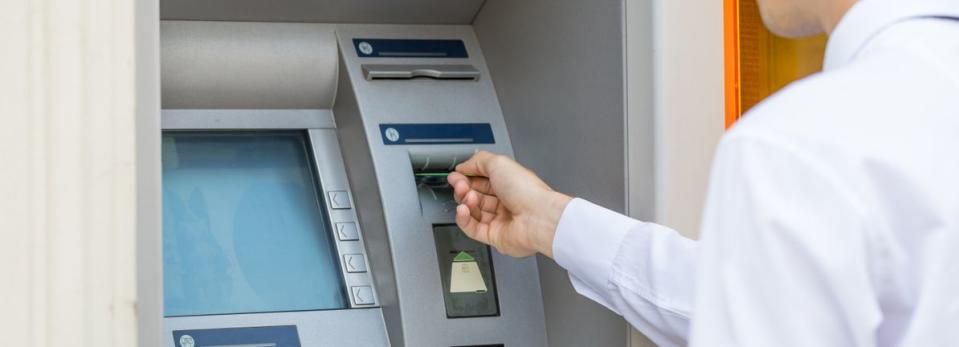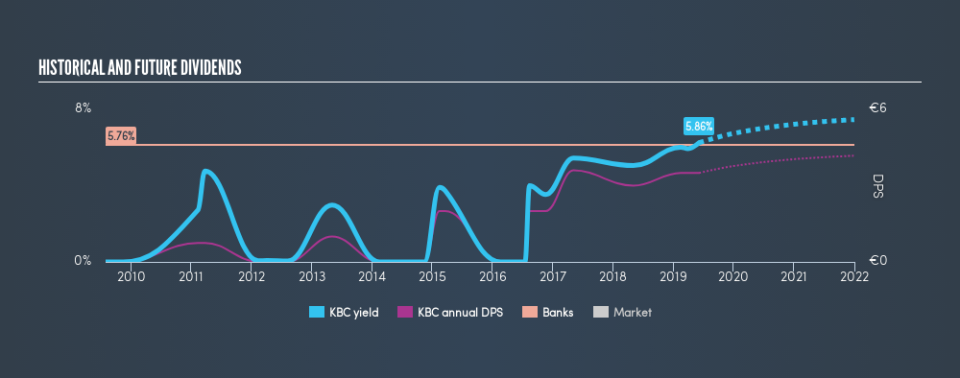Should KBC Group NV (EBR:KBC) Be Part Of Your Dividend Portfolio?

Want to participate in a short research study? Help shape the future of investing tools and you could win a $250 gift card!
Is KBC Group NV (EBR:KBC) a good dividend stock? How would you know? Dividend paying companies with growing earnings can be highly rewarding in the long term. Yet sometimes, investors buy a stock for its dividend and lose money because the share price falls by more than they earned in dividend payments.
With a goodly-sized dividend yield despite a relatively short payment history, investors might be wondering if KBC Group is a new dividend aristocrat in the making. We'd agree the yield does look enticing. Some simple research can reduce the risk of buying KBC Group for its dividend - read on to learn more.
Click the interactive chart for our full dividend analysis
Payout ratios
Companies (usually) pay dividends out of their earnings. If a company is paying more than it earns, the dividend might have to be cut. Comparing dividend payments to a company's net profit after tax is a simple way of reality-checking whether a dividend is sustainable. KBC Group paid out 62% of its profit as dividends, over the trailing twelve month period. This is a healthy payout ratio, and while it does limit the amount of earnings that can be reinvested in the business, there is also some room to lift the payout ratio over time.
Consider getting our latest analysis on KBC Group's financial position here.
Dividend Volatility
One of the major risks of relying on dividend income, is the potential for a company to struggle financially and cut its dividend. Not only is your income cut, but the value of your investment declines as well - nasty. The first recorded dividend for KBC Group, in the last decade, was eight years ago. It's good to see that KBC Group has been paying a dividend for a number of years. However, the dividend has been cut at least once in the past, and we're concerned that what has been cut once, could be cut again. During the past eight-year period, the first annual payment was €0.75 in 2011, compared to €3.50 last year. Dividends per share have grown at approximately 21% per year over this time. KBC Group's dividend payments have fluctuated, so it hasn't grown 21% every year, but the CAGR is a useful rule of thumb for approximating the historical growth.
KBC Group has grown distributions at a rapid rate despite cutting the dividend at least once in the past. Companies that cut once often cut again, but it might be worth considering if the business has turned a corner.
Dividend Growth Potential
With a relatively unstable dividend, it's even more important to see if earnings per share (EPS) are growing. Why take the risk of a dividend getting cut, unless there's a good chance of bigger dividends in future? Strong earnings per share (EPS) growth might encourage our interest in the company despite fluctuating dividends, which is why it's great to see KBC Group has grown its earnings per share at 40% per annum over the past five years. With recent, rapid earnings per share growth and a payout ratio of 62%, this business looks like an interesting prospect if earnings are reinvested effectively.
We'd also point out that KBC Group issued a meaningful number of new shares in the past year. Regularly issuing new shares can be detrimental - it's hard to grow dividends per share when new shares are regularly being created.
Conclusion
Dividend investors should always want to know if a) a company's dividends are affordable, b) if there is a track record of consistent payments, and c) if the dividend is capable of growing. KBC Group's payout ratio is within normal bounds. We were also glad to see it growing earnings, but it was concerning to see the dividend has been cut at least once in the past. KBC Group might not be a bad business, but it doesn't show all of the characteristics we look for in a dividend stock.
Earnings growth generally bodes well for the future value of company dividend payments. See if the 16 KBC Group analysts we track are forecasting continued growth with our free report on analyst estimates for the company.
Looking for more high-yielding dividend ideas? Try our curated list of dividend stocks with a yield above 3%.
We aim to bring you long-term focused research analysis driven by fundamental data. Note that our analysis may not factor in the latest price-sensitive company announcements or qualitative material.
If you spot an error that warrants correction, please contact the editor at editorial-team@simplywallst.com. This article by Simply Wall St is general in nature. It does not constitute a recommendation to buy or sell any stock, and does not take account of your objectives, or your financial situation. Simply Wall St has no position in the stocks mentioned. Thank you for reading.

